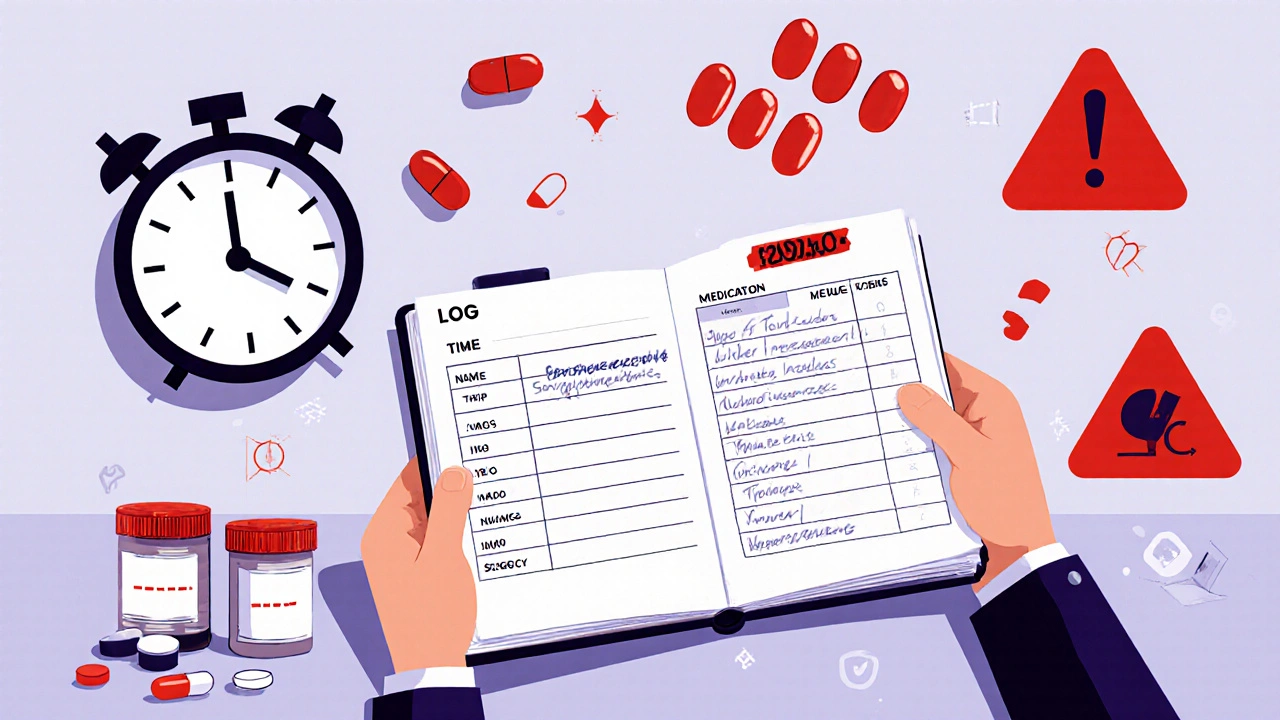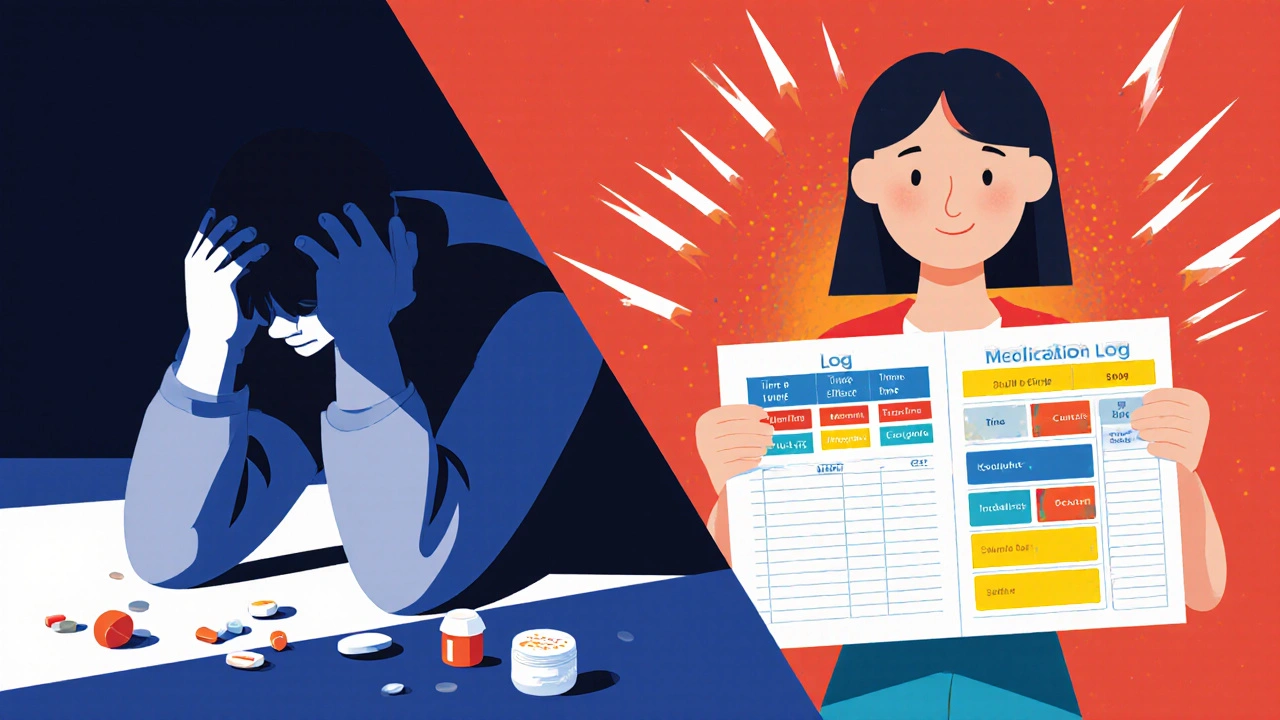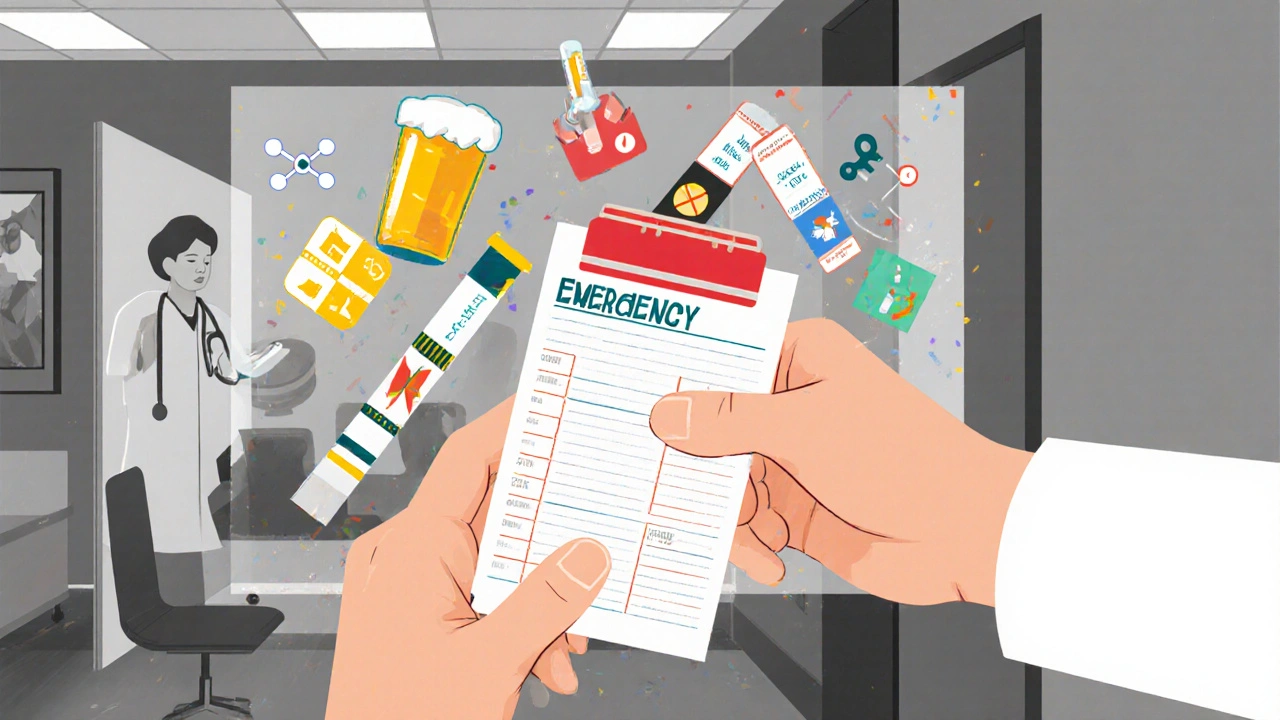SEARCH
How to Use a Medication Log to Prevent Overdose Errors


Every year, thousands of people accidentally take too much of a medication-sometimes because they lost track of what they took, when they took it, or how much. It’s not always about drugs like opioids. It can be painkillers, sleep aids, anxiety meds, or even mixing over-the-counter pills with prescriptions. One wrong dose, one extra pill, one forgotten timing, and the consequences can be deadly. But there’s a simple, powerful tool most people never use: a medication log.
Why a Medication Log Matters
Think about your daily routine. You take pills at different times. Maybe one in the morning, another at night. Sometimes you skip a dose. Sometimes you take an extra because you’re in pain. You might get a new prescription from a different doctor. You might mix it with alcohol, muscle relaxers, or even herbal supplements. Without a record, you’re guessing. And guessing with medication is dangerous. A medication log isn’t just for people with opioid use disorder. It’s for anyone taking more than one medication regularly. It’s for people managing chronic pain, anxiety, insomnia, or heart conditions. It’s for older adults juggling multiple prescriptions. It’s for people who’ve had a bad reaction before and want to avoid it again. The CDC says that combining opioids with alcohol or benzodiazepines increases overdose risk dramatically. SAMHSA warns that crushing pills or changing how you take them-like snorting or injecting-makes dosing unpredictable. A log helps you see patterns. It helps you spot when you’re taking too much, too often, or mixing dangerous combinations.What to Track in Your Medication Log
A good log doesn’t need to be fancy. But it needs to include these five key details for every dose:- Medication name-Use the brand or generic name exactly as written on the bottle. Don’t write “pain pill.” Write “oxycodone 5 mg” or “alprazolam 0.5 mg.”
- Dosage amount-How many milligrams? How many pills? Write the exact number. If you split a pill, note it: “1/2 of 10 mg.”
- Time taken-Use a 24-hour clock if possible. 14:30 is clearer than “2:30 pm.”
- Reason for taking it-“For back pain,” “Couldn’t sleep,” “Anxiety spike.” This helps you spot if you’re using it for the right reasons.
- Effects or side effects-“Felt calm,” “Dizzy for 2 hours,” “Nausea after 30 min,” “No effect.” This is critical. If you notice drowsiness every time you take a med with alcohol, that’s a red flag.
Also track:
- Other substances taken at the same time-Alcohol, marijuana, benzodiazepines, sleep aids, even cough syrup with dextromethorphan. These interactions are silent killers.
- Method of administration-Swallowed? Crushed? Snorted? Injected? SAMHSA says injecting or smoking opioids raises overdose risk significantly. If you’re doing this, your log becomes a safety tool, not just a record.
- Drug test results-If you use fentanyl or xylazine test strips, write down the result. “Tested pill-positive for fentanyl.” This tells you if your supply is contaminated.
How to Start Your Log
You don’t need an app. You don’t need to buy a special notebook. Start with what you have:- Grab a notebook, a sticky note, or even the notes app on your phone.
- At the top, write your name and the list of medications you’re currently taking.
- Each time you take a dose, write down the five key details above.
- Set a reminder on your phone for 10 minutes after you take your meds to log it. Don’t wait until later-you’ll forget.
- Review your log every Sunday. Look for patterns: “I took 3 doses of oxycodone on Tuesday because I was in pain, but I didn’t take any on Wednesday.”
Some people find it helpful to use a printable template. Search for “medication log printable PDF” and pick one with boxes for each category. Print it and keep it in your pill organizer or wallet.

Why Digital Isn’t Always Better
There are apps that track medications. Some even send reminders. But they have risks. If you lose your phone, you lose your log. If you’re in crisis, you might not be able to unlock your phone. A paper log? You can grab it with one hand. You can show it to an ER doctor in seconds. That said, digital logs work well for people who are already tech-savvy and use their phone constantly. Apps like Medisafe, MyTherapy, or even Google Keep can work. Just make sure you back them up. And never rely on an app to remind you to take your meds if you’re high-risk. Use it as a supplement-not a replacement-for awareness.Sharing Your Log Can Save Your Life
One of the most powerful things you can do is share your log with someone you trust. Not just a family member. Someone who will actually pay attention. Someone who knows your habits. SAMHSA recommends never using alone. That’s not just about being physically alone-it’s about being isolated in your use. If you have a log, you can say: “Here’s what I took today. If I don’t answer in an hour, call 911.” Some harm reduction centers give out “overdose safety cards” with space to write your meds and emergency contacts. Keep one in your wallet. Give one to your buddy. Make it part of your routine.Common Mistakes and How to Avoid Them
- Writing vague entries-“Took pain med.” That’s useless. Write the name and dose.
- Only logging when you think you messed up-Consistency matters. Log every time, even if it’s normal.
- Trying to remember doses from memory-You won’t. Write it down immediately.
- Ignoring side effects-If you feel foggy, dizzy, or nauseous after a dose, that’s data. It tells you your body’s limit.
- Not updating when prescriptions change-If your doctor switches you from oxycodone to hydrocodone, update your log right away.
One person told me they started logging after nearly overdosing on a mix of tramadol and alcohol. They didn’t realize tramadol was an opioid. Their log showed they’d taken it 5 times in 48 hours. That’s when they went to their doctor and got help.

How a Log Helps Doctors and Pharmacists
Doctors rely on Prescription Drug Monitoring Programs (PDMPs) to see what prescriptions you’ve filled. But those systems are slow. They show what was prescribed, not what you actually took. A medication log shows your real behavior. If you bring your log to your appointment, your doctor can see:- Are you taking more than prescribed?
- Are you mixing dangerous drugs?
- Are side effects getting worse?
- Is your pain management working?
This isn’t about getting in trouble. It’s about getting better care. Your log gives your provider the full picture. It helps them adjust your treatment safely.
It’s Not About Control. It’s About Safety.
Some people think keeping a log means they’re addicted or “failing.” That’s wrong. Keeping a log means you care. It means you’re taking responsibility for your health. It means you’re smarter than the system that tells you to just “take one pill and hope for the best.” Overdose doesn’t happen because someone is weak. It happens because someone didn’t have the tools to see the danger coming. A medication log is that tool. It doesn’t fix addiction. It doesn’t cure pain. But it gives you control. It gives you clarity. And in moments of confusion, that clarity can be the difference between life and death.Start today. Write down your next dose. Not tomorrow. Not when you feel like it. Now. Your life depends on it more than you know.
Can I use a phone app instead of a paper log?
Yes, but only if you’re confident you’ll always have your phone and can unlock it quickly. Apps like Medisafe or MyTherapy can send reminders and back up data. But in an emergency, a paper log is faster and doesn’t need a password or battery. Use both if you can-app for reminders, paper for emergencies.
What if I forget to log a dose?
Don’t panic. Don’t try to guess and backdate it. Just write “Missed entry” and move on. The goal isn’t perfection-it’s awareness. If you miss one, try to set a reminder for the next time. Consistency builds over time, not all at once.
Do I need to log over-the-counter meds too?
Yes. Many overdoses happen from mixing OTC drugs with prescriptions. Cold medicines with dextromethorphan, sleep aids with diphenhydramine, and pain relievers like acetaminophen can all cause dangerous interactions. Log everything you take-even aspirin or melatonin.
How often should I review my log?
Check it weekly. Look for patterns: Are you taking more on weekends? Do you always take extra when stressed? Are you mixing alcohol with certain meds? Weekly reviews help you catch risky behavior before it becomes a crisis.
Can a medication log help if I’m not on opioids?
Absolutely. Overdose isn’t just about opioids. Benzodiazepines, sleep meds, and even high doses of antidepressants can be fatal in combination. People overdose on mixing alcohol with anxiety pills, or taking too many Tylenol PMs. A log helps you track all medications-not just the ones you think are dangerous.
Where can I get a free medication log template?
Many harm reduction organizations offer free printable logs. Try searching for “free medication log PDF” from SAMHSA, the National Harm Reduction Coalition, or your local public health department. You can also create your own in Google Docs or Excel using the five key details listed above.
Next Steps: Make It Part of Your Routine
You don’t need to be perfect. You just need to start. Here’s what to do right now:- Find a notebook, sticky note, or open your phone’s notes app.
- Write down the names and doses of every medication you take daily.
- Set a phone alarm for 10 minutes after your next dose to log it.
- Write down what you took today-right now.
- Give a copy to someone you trust.
This isn’t about being watched. It’s about being safe. You’re not alone in this. Thousands of people use logs to stay alive. You can too.
Olanrewaju Jeph
November 21, 2025 AT 16:46Starting a medication log is one of the most responsible things you can do for your health. I’ve seen people overlook simple systems like this until it’s too late. Writing down each dose-even the small ones-creates accountability. It’s not about control; it’s about awareness. I keep mine in a small notebook in my wallet. When I go to the pharmacy or ER, I hand it over without hesitation. It’s saved me from dangerous interactions more than once.